Tobago
17th September - 27th October 2003
We left Trinidad on the evening of 16th September with trepidation, mindful of all the horror stories of passages to Tobago, its sister island, lying about 60 miles away against the prevailing tradewinds and 2 -3 knot current. Many cruisers who'd never ventured there had told us we'd never make it with our 30 hp engine. We were, however, a little more determined and followed the advice of locals who had actually made the trip! We stuck with our plan of selecting a time when the Atlantic swell was small and travelling close to shore and overnight, when the wind usually dies away. For once everything went to plan! We left our TTSA anchorage around 5 pm and passed through the Boca channel to the north coast of Trinidad as the tide began to fall. For about four hours we actually had current pushing us in the right direction, helping our little engine out. By 5 am we'd made it as far as Galera Point, the eastern most point of Trinidad's north coast and changed course to head direct for Tobago. We were safely anchored in Store Bay in time for breakfast.

When we began exploring Tobago, we quickly learned a thing or two about getting around there. The first was that, with the exception of Charlotteville in the north which had a dock, whenever we went ashore, we had to beach our dinghy in the often large swell. Almost every time, we ended up wet from the perilous endeavour of leaping out of the dinghy in the surf onto the steeply shelving and exposed beaches. The task of transferring a month's supply of bulky shopping items, such as milk, juice and beer, from the back of a taxi, down the beach, up to thigh depth in water with waves coming in every few seconds and then into the dinghy, which we'd anchored as we'd be unable to move it down the beach with the large load aboard, was unpleasant and sometimes risky. Even pulling the dinghy up the beach was difficult for just the two of us, due to the steepness and softness of the golden sand. Several times we almost came to grief, the worst occasions being when a large swell flipped the dinghy over on top of us just as we'd leapt out and once, when for the first time ever, the outboard engine jammed in the down position, leaving the dinghy impaled in the sand and being beaten by big swells. We certainly came to appreciate the luxury of having a dock to tie up our dinghy on!
We also quickly learned that if you followed the advice you were given as a child to "never get into a car with a stranger", you'd never get anywhere in Tobago. Although there was a public bus system, we realised after waiting until 4.45 pm firstly for the the non-existent 2.15 pm and then the 4 pm buses from Scarborough to Charlotteville to show up, why the locals preferred the "route taxis". For shorter distances, these were simply private cars which picked up anybody needing a lift who they passed on their fixed routes. These vehicles had no distinguishing marks at all, you simply had to stick your arm out at every passing vehicle to find one. On longer journeys minibuses were used, similar to the maxi-taxis in Trinidad. The drawback with these was that unless you were "in the know" about when they would show up, you could be standing around waiting for a long time. There seemed to be no timetable to speak of. Having said that, if there was a timetable, it may have been as reliable as the one for the public buses!
Most of the tourism in Tobago was centred in the south west section of the island but the island was largely unspoilt by development. Once we'd stocked up in Store Bay, we set off north east up the west coast of the island in search of less developed anchorages.
We took a scenic walk along the stream (sometimes through the stream) up to the village's waterfall. On our way we searched in the water for guppies and other tropical fish. Despite our best attempts we failed to catch any new additions for our on-board spaghetti jar aquarium. Perhaps a tea strainer wasn't the best device to try and catch them with! Once we reached the waterfall, Phil decided to climb up to the top as the locals do. It was only when he reached the top that he suddenly wondered how he would get back down the slippery wet rock again - it was a lot easier climbing up. Eventually he made it safely back down and resolved never to climb a waterfall again, especially when the elbow he'd injured when he slipped swelled to the size of an ostrich egg!

Castara's Bakery

"How do I get down again?"

Fearless Guppy Hunter!
After a few days we suddenly went from being alone in the anchorage to being surrounded by a dozen other yachts. They were all invited by our friends Phil and Nicola on Splendid Adventurer to an "oildown", to be held in the village in honour of their visiting friends. The "oildown" was a chicken stew or soup, with dumplings and lots of root vegetables, cooked over an open fire, using the large cast iron pots in which whale blubber was reduced in the days of whale hunting. Of course it was spiced up with "Captain Phil's Wreck Tum Fire", the hot sauce produced by Phil and Nicola's company and all washed down with lots of rum punch! Although the meal didn't look too appetizing, it was very tasty!
Oildown chefs hard at work.


Hungry Cruisers waiting for food

The finished product.
We'd spotted lots of bats flying at night in both Trinidad and in Tobago. One day we were lucky enough to see the fruit bats flying during the day when they were disturbed by a local boy collecting coconuts from the top of the palm in which they roosted. He even gave us a couple of coconuts! On a different day we again saw the bats flying in daylight, to retrieve a small baby bat which had fallen to the ground.
We decided it was time to leave Castara when we awoke one morning to feel a violent swell and hear our TV crashing across the cabin. Luckily it survived unscathed. We set off to Charlotteville and had a hard trip, mostly due to that same swell and the wind, both on our nose all the way. After a couple of hours of pounding we pulled into another small village called Parlatuvier but after having to re-anchor three times, when we found ourselves too close to the fishing boats or the rocks in the tiny bay, we decided to carry on Charlotteville at the northwest of the island.
Compared to Castara, Charlotteville was a city! It boasted two shops, one with internet connection, as well as a couple of stalls selling fruit, veg and snacks at the roadside. Snorkeling was wonderful there when the swell died down and the water became crystal clear. Luckily we were anchored close enough to swim straight to the reef from our boat, so we could make frequent trips. We were again impressed by the stunning variety of corals and fish and this time were frightened by a large ugly Green Moray Eel with big teeth, which came a bit too close for comfort!
Soon we were reunited with Phil and Nicola when they anchored behind us and we set off together in search of adventures. They were very familiar with the area, which they have been visiting for years during the hurricane season, and they were able to show us all the best spots. Normally they are based in Mustique, where they charter their catamaran.
They introduced us to their friend Madison Christmas, a cheerful old man who used to work on the cocoa plantation many years ago. He was still employed looking after the grounds and we exchanged some chicken and rice with him for some succulent avocados from his garden.
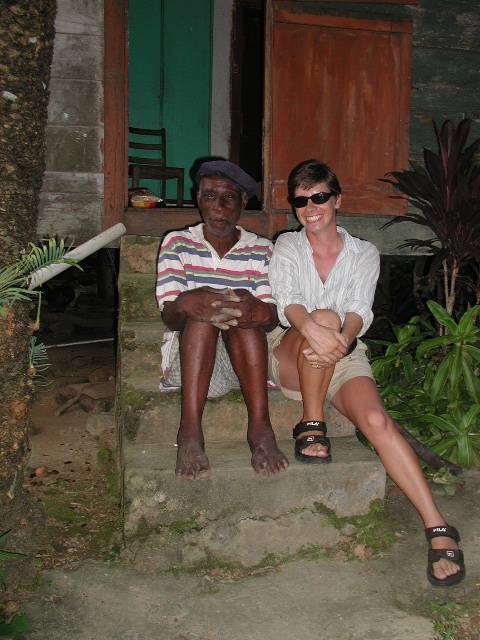
Meeting Madison Christmas.
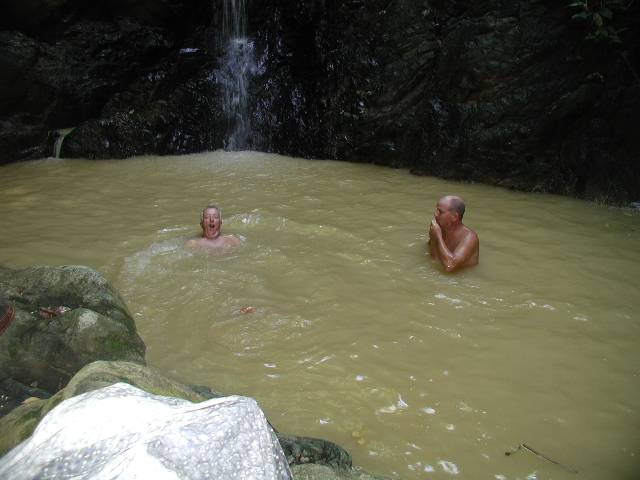
"Is it cold in there?"
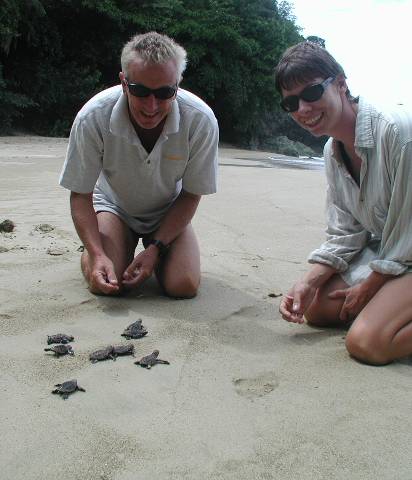
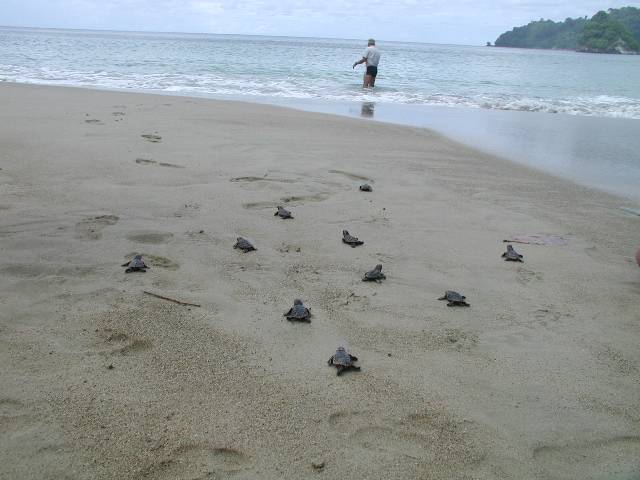
Helping the turtles out to sea.
Willy's arrival.
We were lucky enough to see one of the eggs hatch out over a period of about an hour. When "Willy", as he was christened, finally emerged he was unfortunately very weak and the underside of his shell not properly bonded together, leaving some of his stomach exposed. We kept him overnight in a container of sea water, to give him a chance to rest before releasing him to sea, hoping he would survive.
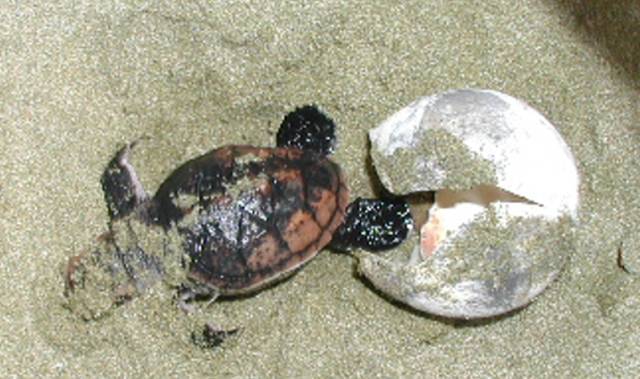
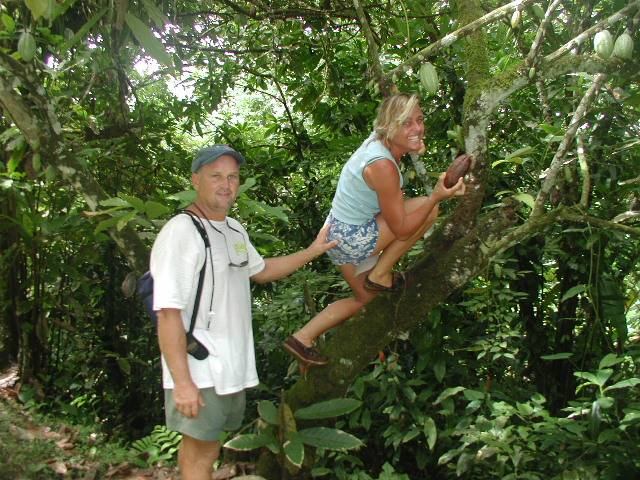
Phil and Nicola harvesting cocoa pods in the forest.
Our on-board pets the guppies hadn't been doing too well either and in Tobago we were down to only three, a mother and two of her offspring. During the night, the mother strangely disappeared from the container without a trace. It was a mystery, neither of the remaining guppies was big enough to have eaten her and we searched the entire container, even inside the shells. After that we thought no more about it. A couple of nights later one of the remaining guppies did the same disappearing act. We were completely baffled. We could only assume that we had a sinister guppy snatcher aboard. From then on, lonely Miss Guppy slept with the lid on her container! Mr Jumpy, our stowaway spider from Trinidad, is a prime suspect.
Phil took a fishing trip out to sea with local fisherman Winston, otherwise known as "Black Mouth". He was collected at 6 am by Winston and returned about four hours later. Between them they managed to catch eight tuna, one of which we shared with Phil and Nicola. After the experience Phil was exhausted and decided he wouldn't like to be a fisherman for a living!
We were delighted to hear from Eugene and Kirsten of Sandpiper that they were heading from Grenada to Trinidad and on learning that we were in Tobago, they'd decided to join us there for a few days on their way south. We'd been trying to get together with Sandpiper, who we'd last seen in Cascais, Portugal, since they arrived in the Caribbean a year ago. We were often close but had never quite managed to meet up. It was great to see them again after two years and catch up. Phil now had Eugene as a new fishing partner. We travelled south down the coast back towards Store Bay together, stopping on the way at the tranquil anchorages of Bloody Bay and Englishman's Bay overnight. On arrival at Store Bay we decided to hire a car together to tour the island.
First we wanted to visit the Hillsborough Dam at the large reservoir in the interior of the island, where you can spot caiman if you're lucky. We weren't! After the hour long drive along the winding track to reach the dam, we were told it was closed due to "a threat against the water supply".
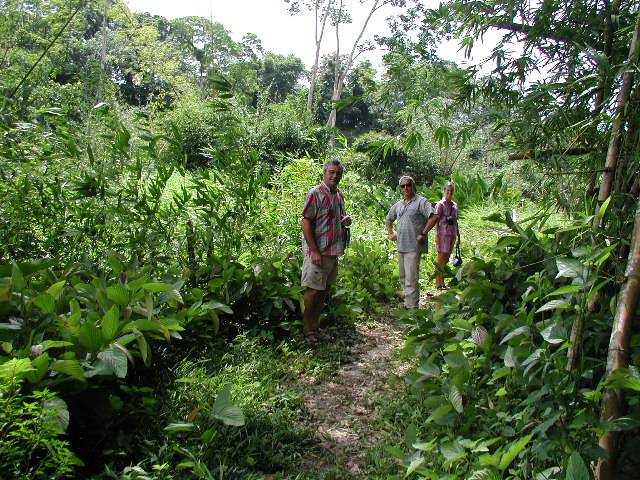
In search of Rainbow Falls with Eugene and Kirsten.
It was by chance that the combination of the time spent in the petrol queue and the wrong turns and detours we'd taken meant that we arrived at the Caledonia Grafton Bird Reserve at 4.30 pm, just at the right time to witness feeding time. The reserve was very peaceful and we wished we had longer to spend there. Next time we'll be sure to spend more time there and to wear long trousers and long sleeved shirts to keep the bugs at bay. We were finally able to see the famous "Cocrico" and many other birds including Mot-Mot and Bananaquit.
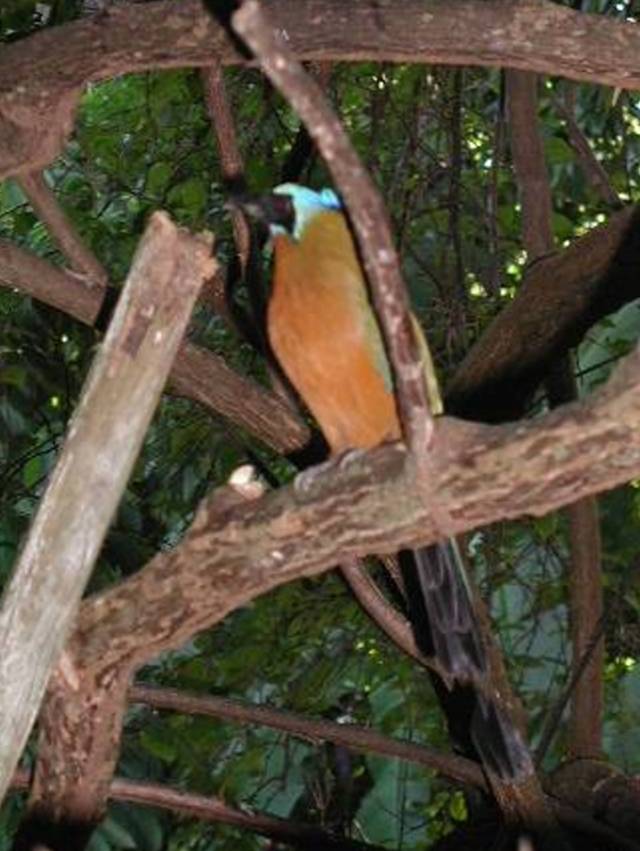
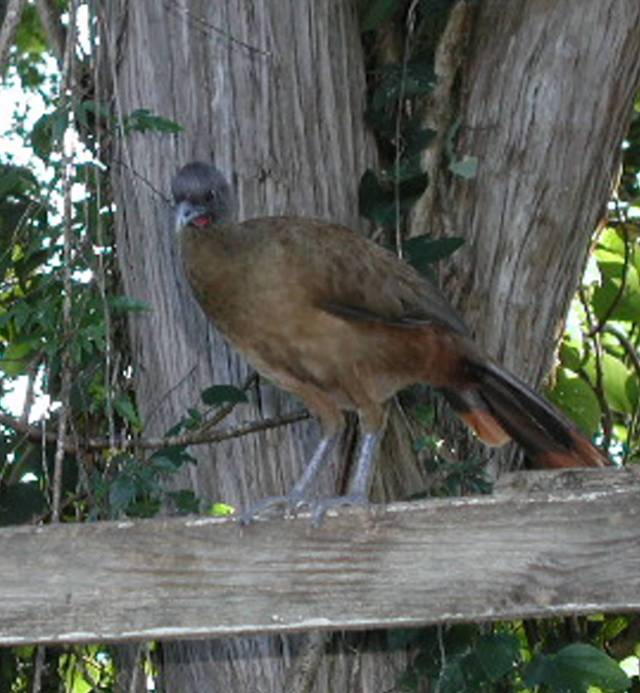
Beautiful Mot-Mot and Raucous Cocrico at the Caledonia Grafton Bird Reserve.